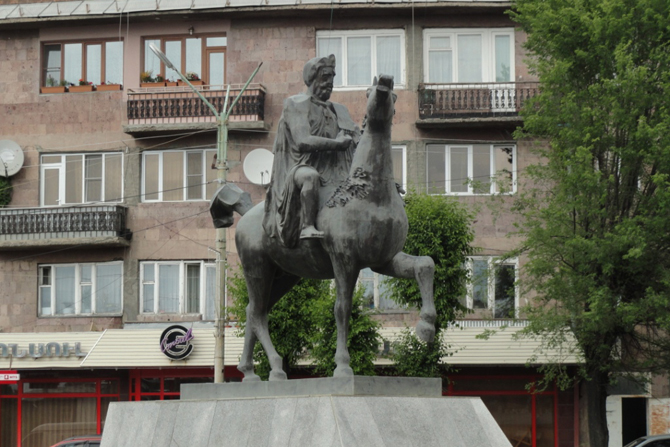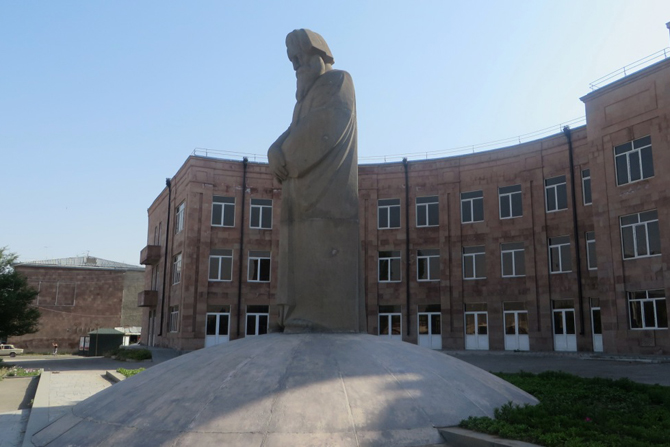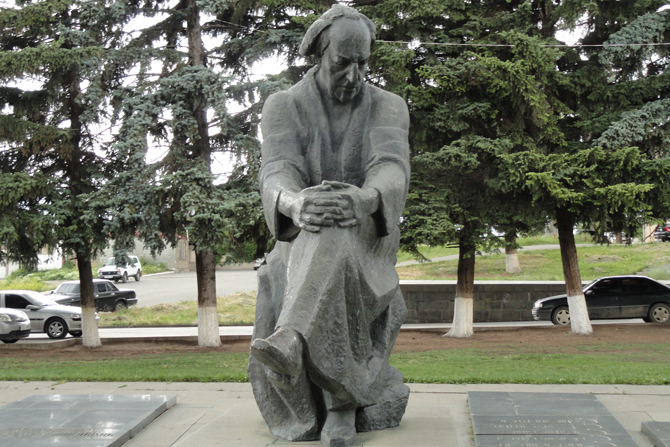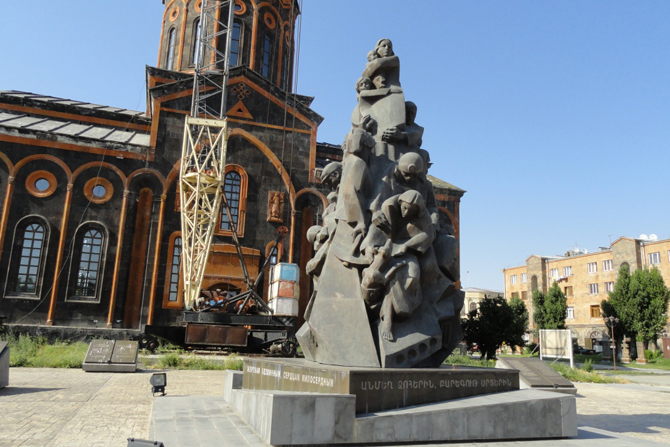
Gyumri: A City of Statues, But at What Cost to Struggling Taxpayers?
According to the latest official count, Gyumri (Armenia’s second largest city with a population hovering around 130,000) has 99 statues and busts.
Is such a number too much for a city attempting to free itself from the grips of poverty? I posed this question to Araksya Margaryan, a Gyumri resident and artist.
“I cannot say if the number is too big or small, but there’s no doubt that 90% of the statues installed during the past ten years have no connection with art. I believe that what was spent on them simply was a waste of money,” Margaryan said.
 |
| Araksya Margaryan |
“Do you know why the Vardanants group of statues was installed in the central square of Gyumri? It’s because the former mayor really wanted to immortalize his name. The group of statues was installed and the square names Vardanants even though there were opposing opinions about the statues,” Margaryan noted. (Hetq – Vardan Ghukasyan was the former mayor of Gyumri)
Margaryan says that every piece of public art, statue or bust, serves as the calling card of a given community and the question to be asked is to what extent do they reflect the reality of the day and whether they convey the correct messages.
In the Soviet era, statues of prominent revolutionaries, representatives of the peasant/worker class, beloved poets and epic heroes were installed. The messages they conveyed were clear – power, victory, work, art, and respect for ones forbearers. Gyumri was no exception. Take the statue of Avetik Isahakyan opposite the Drama Theater and Mother Armenia by sculptor Ara Sargsyan. The statute of the revolutionary Stepan Shahumyan still stands in Gyumri.
‘Today, sadly, there is a very narrow and subjective approach to art,” Margaryan says. “In the Soviet period there was an advisory board comprised of architects, painters and artists which decided what would be installed and where. Today, such selections are made behind closed doors or by one person.”

Ashot Voghormatz (Ashot the Merciful)
The ‘statue boom’ in Gyumri began during the tenure of Vardan Ghukasyan as mayor. Celebrations were accompanied by the unveiling of a statue. The statue of Ashot Voghormatz was unveiled in 2008 on the occasion of City Day in Gyumri. It’s no surprise that the Bagratuni King Ashot III was known as a benefactor during whose reign schools, hospitals and poorhouses were opened.

Hayouhie (Armenian Woman)
“This statue, from an aesthetic viewpoint and given its location, has no justification, especially in the middle of town,” notes Margaryan. “The idea wasn’t bad but the result is disappointing. Originally, the statue was called the ‘saint’ because it had a halo. The halo was removed by the order of the church. But even that didn’t help. It had no connection with the square. It leaves the impression of an artificially installed element. If this statue were to be placed in a much more graceful location, on a much more modest pedestal, it would have a more imposing effect. The Anania Shirakatsi statue is in the same ridiculous condition. It looks more like Father Christmas, situated as it is on some incomprehensible semi-round base,” Margaryan says.

Anania of Shirak
In an interview given a few years ago, Shirak Primate Archbishop Ajapahyan said that the conceit displayed by former Gyumri mayor Ghukasyan was so great that he regarded himself as the highest figure in the town and that he even outclassed the primate and the provincial governor. “He was like a fuehrer. Then came God, or he likened himself to God,” was what Ajapahyan said.
The current municipal government says it doesn’t want to continue the policies of the past. Nevertheless, Gyumri’s Chief Architect Henrik Gasparyan, who also served under Ghukasyan, says that while he agrees that the center of town is overburdened with statues he doesn’t see anything particularly wrong in that.
 |
| Henrik Gasparyan |
Henrik Gasparyan even boasts that a museum of various sculptures will be constructed adjacent to the Kumayri Preserve.
He describes it as a place where statues from various locales, statutes of Lenin for example that have been removed but not destroyed, will be assembled. Gasparyan sees it as a step to attract tourists to the area.
As to the process regarding the installation of statues in Gyumri, Gasparyan said it’s either at the request of the municipality or at the suggestion of benefactors.
“In the past it was a one person decision but now there is a committee of architects, artists, etc. They decide what statues to install and where,” Gasparyan said.

Sayat Nova
Three statues have been installed under the tenure of the new Gyumri mayor, Samvel Balasanyan. All three, including the one of Sayat Nova, have been criticized. The same holds true for the Rebirth sculpture.
Gasparyan says that those that cannot resist public pressure will ultimately be removed.

Rebirth Memorial
Margaryan says that the Rebirth Memorial, if it is truly dedicated to the martyrs of 1915, shouldn’t have been placed in a park in the center of town that has become a hangout for bums.
“If it symbolizes rebirth, when has a pair of outstretched hands holding a cross symbolized rebirth? It’s incomprehensible and the assumption is that it was foisted on the town. You have the pitiful Ashot Voghormatz statue, which has nothing royal about it, where the horse looks more like a donkey. Then they installed the Sayat Nova statute, another incomprehensible thing, which expresses pity more than anything else,” Margaryan said.
Margaryan is also opposed to benefactors forcing the town to install statues and believes that every time the municipality agrees it’s a display of a poor man’s mentality – we can’t look a gift horse in the mouth.
“And what does a benefactor’s offer mean? A benefactor can suggest many things, but must we accept them? Aren’t there people left in Gyumri who understand art? People who can say wait a minute; we don’t need this or that?” Margaryan said.

Avetik Isahakyan
Gyumri’s Chief Architect Gasparyan believes that any statue must pass the test of time.
“The sculptor of the Avetik Isahakyan statue, installed in the Soviet era, was awarded a medal. The statue gained acceptance and stands today. The same holds true for the Stepan Shahumyan statue that was never dismantled,” said Gasparyan, adding that new generations will ultimately decide if a statue is worthy of remaining or not.
Margaryan noted that some unappealing statues with nothing to say are also the reflection of the commercial success of certain sculptors, and questioned why orders go to the same people.
More statues or money down the drain?
Lena Djilavyan, who heads the finance department at the Gyumri Municipality, wasn’t able to provide all the contracts for statues and busts installed during the past ten years. She confessed that the process wasn’t all that transparent in the past.
Djilavyan said that there were often cost overruns that have accumulated over time.
“Take the Vardanants group for example that was unveiled in 2009. According to the contract, the value was estimated at 54.6 million AMD. The sculptor, Artoush Papoyan was only paid 38 million. We had to make up some of the difference,” she said.
For his Ashot Voghormatz work, sculptor Ferdinand Arakelyan was paid 28 million AMD. There’s a 31 million contract for Samvel Petrosyan’s Anania of Shirak, but former mayor Vardan Ghukasyan refused to pay him. On the day when the statue was unveiled, Arakelyan told the press it was his gift to the town. The town paid 7 million AMD for the Sayat Nova statue.

Memorial to Earthquake Victims
There are no contracts for the works of sculptor Frid Soghoyan installed in Gyumri during the past few years.
Soghoyan’s Rebirth Memorial was the desire of a benefactor residing in Moscow. It was unveiled in the town’s central park on April 24. Funds from the national and municipal budgets were allocated for the statue dedicated to the 1988 earthquake victims that now stands in the courtyard of the Holy Savior Church.
There are no records to be found regarding the grouping of statues known as the Duduk Players.
Top photo: Vardanants grouping
 Videos
Videos Photos
Photos
Comments (7)
Write a comment